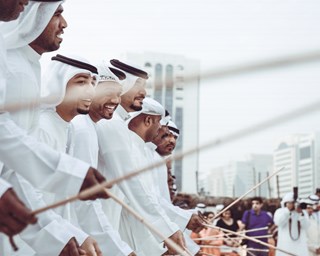Al Ayala
Al Ayala is a unique folk art performed in the UAE. It has been the UAE’s primary form of national and cultural expression, seen by rulers, dignitaries, and the public. Historically, Al Ayala was associated with the culture and chivalry of the nomadic Bedouins, or ‘desert dwellers’. It is a heritage and cultural tradition symbolizing the UAE’s past, as well its contemporary identity. More recently, Al Ayala has become a popular means of celebration in weddings and other social gatherings.

Types of Al Ayala
One style of Al Ayyala that began in the UAE’s desert oases community is called Ayyalat Ahl Albar or Razfat Al-Ayyala (the inland version). This style is practiced by some tribes in Abu Dhabi and Al Ain, This is performed by desert people and not accompanied by any percussion rhythms but rather by a chant without any rhythm or instruments. This sound recited by a chanter resembles eloquent poetry. Another Al Ayala style, Ayyalat Ahl Albahr or Ardhat Al-Ayyala (the coastal version) is performed in coastal regions from the city of Abu Dhabi to Fujairah , with three rhythmic tunes and the dancing is accompanied by percussion instruments such as the al-kaasir (large drums), al-rahmani (smaller drums), al-defuf (tambourines), and al-tous (brass cymbals).

Performances
Al Ayala performances simulate a battle scene, with performers forming two rows opposite each other, carrying thin bamboo sticks to represent spears or swords. Each row of performers engages in alternate moves, signifying victory or defeat; they chant poetic lyrics and move their heads and sticks in sync with the drum rhythm beat. Al Ayala performances are governed by a fixed set of rules and have a leading figure, called al abu (the father) or al ras (the head). Between the two rows are drummers ( Al alzana) and (al jaweela), who move around in a circular fashion holding swords or guns that they occasionally hurl to the sky and catch. Several girls (called al na'ashat) stand at the head of the rows.
Al Na’ashat
Al Na’ashat is a dance is performed within Al Ayala. In this dance, young women stand in front of the two rows of men and toss their long hair from side to side, signifying their faith in protection offered by chivalrous male performers. Their performance is in harmony with the rhythm of the traditional music accompanying Al Ayala. The young women wear ornate regional dresses called al mekhwar and often gold and jewellery such as murta'asha, murreya and other accessories. It is claimed that the origin of Al Na’ashat within Al Ayala performances can be traced back to wars and raids in ancient times. Back then, young women went out of their houses and removed their head coverings to raise the spirit of the men, in order to motivate them to defend the honour of the tribe.

Instruments
Al Ayala uses a number of different percussion instruments to support vibrant lyrics with appropriate rhythms. Al ras are big drums with a deep sound, al takhameer are smaller drums, al defuf are hand-beaten tambourines, in addition to other supporting instruments such as brass cymbals, known as al tous, and bamboo sticks. The drum is an ancient percussion instrument that comes in different shapes and sizes, the head of which is made out of goatskin. It is normally used to produce various sounds and perform different functions. It is commonly played by hand or using a stick made out of palm fronds.

Al Ayala and UNESCO
UAE has successfully recorded Al Ayala on UNESCOs Representative List of Intangible Cultural Heritage Items of Humanity in November 2014, in cooperation with Oman. Being part of this important list will contribute towards reviving and promoting Al Ayala as part of the region’s national identity and the heritage of humanity as a whole. Additionally, this listing helps in transferring knowledge, skills, and the values of Al Ayala from one generation to another - and contributes towards achieving respect, mutual understanding, and peace amongst the people of the UAE.